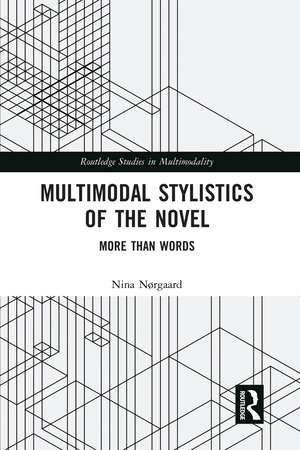Multimodal Stylistics of the Novel: More than Words: Routledge Studies in Multimodality
Autor Nina Nørgaarden Limba Engleză Paperback – 30 iun 2020
| Toate formatele și edițiile | Preț | Express |
|---|---|---|
| Paperback (1) | 311.81 lei 3-5 săpt. | +24.08 lei 4-10 zile |
| Taylor & Francis – 30 iun 2020 | 311.81 lei 3-5 săpt. | +24.08 lei 4-10 zile |
| Hardback (1) | 768.30 lei 6-8 săpt. | |
| Taylor & Francis – 12 oct 2018 | 768.30 lei 6-8 săpt. |
Din seria Routledge Studies in Multimodality
-
 Preț: 153.49 lei
Preț: 153.49 lei -
 Preț: 309.90 lei
Preț: 309.90 lei -
 Preț: 310.71 lei
Preț: 310.71 lei -
 Preț: 311.37 lei
Preț: 311.37 lei -
 Preț: 279.17 lei
Preț: 279.17 lei - 18%
 Preț: 1000.27 lei
Preț: 1000.27 lei - 26%
 Preț: 845.69 lei
Preț: 845.69 lei - 18%
 Preț: 1000.93 lei
Preț: 1000.93 lei - 16%
 Preț: 264.38 lei
Preț: 264.38 lei -
 Preț: 387.38 lei
Preț: 387.38 lei -
 Preț: 432.29 lei
Preț: 432.29 lei - 18%
 Preț: 1000.27 lei
Preț: 1000.27 lei -
 Preț: 388.13 lei
Preț: 388.13 lei -
 Preț: 413.33 lei
Preț: 413.33 lei -
 Preț: 484.08 lei
Preț: 484.08 lei - 20%
 Preț: 260.45 lei
Preț: 260.45 lei -
 Preț: 391.61 lei
Preț: 391.61 lei - 26%
 Preț: 821.53 lei
Preț: 821.53 lei -
 Preț: 385.08 lei
Preț: 385.08 lei - 26%
 Preț: 764.20 lei
Preț: 764.20 lei - 18%
 Preț: 993.97 lei
Preț: 993.97 lei - 31%
 Preț: 763.00 lei
Preț: 763.00 lei -
 Preț: 383.50 lei
Preț: 383.50 lei - 18%
 Preț: 1108.37 lei
Preț: 1108.37 lei - 31%
 Preț: 764.22 lei
Preț: 764.22 lei -
 Preț: 441.22 lei
Preț: 441.22 lei - 18%
 Preț: 1000.27 lei
Preț: 1000.27 lei -
 Preț: 414.32 lei
Preț: 414.32 lei - 18%
 Preț: 998.56 lei
Preț: 998.56 lei - 25%
 Preț: 881.61 lei
Preț: 881.61 lei -
 Preț: 486.42 lei
Preț: 486.42 lei -
 Preț: 387.58 lei
Preț: 387.58 lei - 25%
 Preț: 879.65 lei
Preț: 879.65 lei -
 Preț: 383.12 lei
Preț: 383.12 lei - 18%
 Preț: 1055.51 lei
Preț: 1055.51 lei - 18%
 Preț: 1056.95 lei
Preț: 1056.95 lei - 12%
 Preț: 325.34 lei
Preț: 325.34 lei
Preț: 311.81 lei
Nou
Puncte Express: 468
Preț estimativ în valută:
59.67€ • 64.79$ • 50.12£
59.67€ • 64.79$ • 50.12£
Carte disponibilă
Livrare economică 01-15 aprilie
Livrare express 15-21 martie pentru 34.07 lei
Preluare comenzi: 021 569.72.76
Specificații
ISBN-13: 9780367584542
ISBN-10: 0367584549
Pagini: 366
Dimensiuni: 152 x 229 x 19 mm
Greutate: 0.49 kg
Ediția:1
Editura: Taylor & Francis
Colecția Routledge
Seria Routledge Studies in Multimodality
Locul publicării:Oxford, United Kingdom
ISBN-10: 0367584549
Pagini: 366
Dimensiuni: 152 x 229 x 19 mm
Greutate: 0.49 kg
Ediția:1
Editura: Taylor & Francis
Colecția Routledge
Seria Routledge Studies in Multimodality
Locul publicării:Oxford, United Kingdom
Public țintă
Postgraduate and UndergraduateCuprins
Figures. Permissions. Preface. 1 Introduction. 1.1 Aims and motivations. 1.2 Structure of the book. 2 Multimodal stylistics – what, why and how? 2.1 Preliminaries. 2.2 Stylistics. 2.2.1 Formalist stylistics. 2.2.2 Functionalist stylistics. 2.2.3 Historical stylistics. 2.2.4 Cognitive stylistics. 2.2.5 The cornerstones of stylistics. 2.3 Social semiotic multimodal theory. 2.3.1 Multimodality, modes and semiotic resources. 2.3.2 Discourse, design, production and distribution. 2.3.3 Further remarks on social semiotic multimodal theory. 2.4 Multimodal stylistics. 2.4.1 Motivations and challenges. 2.4.2 Multimodal stylistics today. 2.4.3 Doubly deictic subjectivity, mimesis and defamiliarisation. 2.4.4 Other approaches to multimodality and the novel. 2.5 Further methodological considerations. 2.5.1 Literary data I: multimodality and the novel. 2.5.2 Analytical focus – text, context, author, reader. 2.5.3 Literary data II: selection and representation of examples. 2.6 Concluding remarks. 3 Wording. 3.1 Preliminaries. 3.2 Experiential meaning – language as representation. 3.2.1 Experiential meaning in The sound and the fury. 3.3 Interpersonal meaning – Language as exchange. 3.3.1 Interpersonal meaning in The sound and the fury. 3.4 Textual meaning – Language as text. 3.4.1 Textual meaning in The sound and the fury. 3.5 Faulkner’s text as a functional act of communication between author and reader. 3.6 Concluding remarks. 4 Typography. 4.1 Preliminaries. 4.2 A social semiotic multimodal approach to typography. 4.2.1 Typographic distinctive features. 4.2.2 Typographic semiotic principles. 4.2.3 Metafunctions and typography. 4.3 Typographic meaning in the novel. 4.3.1 Index. 4.3.2 Icon. 4.3.3 Discursive import. 4.3.4 Symbol. 5.1 Concluding remarks. 5 Layout. 5.1 Preliminaries. 5.2 Kress and van Leeuwen’s systems for the analysis of layout. 5.2.1 Information structure. 5.2.2 Salience. 5.2.3 Connectivity: framing and linking. 5.3 The meaning of layout in the novel. 5.3.1 Paragraphs, sections, chapters and pages. 5.3.2 Other types of text block. 5.3.3 Letter spacing, line spacing, blank space. 5.3.4 Linking. 5.4 Concluding remarks. 6 Photographs, drawings and other graphic elements. 6.1 Preliminaries. 6.2 Kress and van Leeuwen’s visual grammar. 6.3 The meaning of photographs, drawings and other graphic elements in the novel. 6.3.1 Photographs. 6.3.2 Drawings. 6.3.3 Other graphic elements. 6.4 Concluding remarks. 7 The book cover. 7.1 Preliminaries. 7.2 Graphic book cover designs – The curious incident of the dog in the night-time. 7.3 Photographic book cover designs – On the road. 7.4 Film tie-ins and bestseller emulation – discursive import and the significance of context. 7.5 Concluding remarks. 8 The materiality of the novel. 8.1 Preliminaries. 8.2 The book as a three-dimensional object. 8.3 The physical form of cover and binding. 8.4 The semiotics of paper. 8.5 Concluding remarks. 9 Conclusion. 9.1 Preliminaries. 9.2 Insights and contributions. 9.3 Further directions. Appendix A: Colour images. Appendix B: The multimodal stylistics toolkit. Index.
Notă biografică
Nina Nørgaard is Carlsberg Semper Ardens Research Fellow and Associate Professor of Applied Linguistics in the Department of Language and Communication at the University of Southern Denmark, where she is also director of Centre for Multimodal Communication. Nina is the author of numerous articles and book chapters on multimodal stylistics.
Descriere
This book advocates for a new analytical framework that extends our understanding of multimodal meaning-making in the novel.
